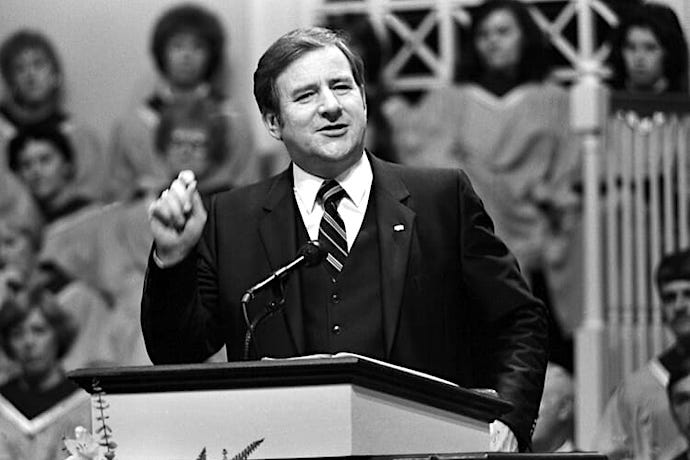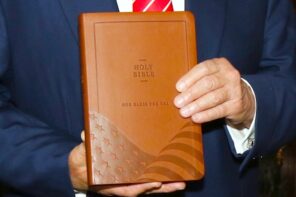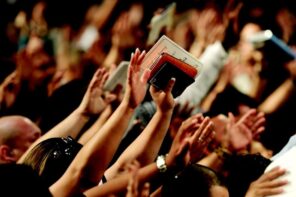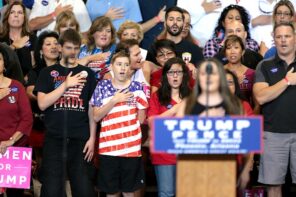In autumn 1980, I was a senior at a Christian college in California taking a course on the history of American evangelicalism. One November day, a fellow student brought a copy of the New York Times to class. With a dramatic flourish, he opened the paper and pointed to a story—“Falwell Warns Jersey Liberals at Capitol Rally”—accompanied by a picture of Baptist preacher Jerry Falwell on the steps of the Trenton State House surrounded by American flags and a church choir.
The story began:
“The Rev. Jerry Falwell, the leader of the Moral Majority movement, brought his mixture of church meeting and political rally to the New Jersey State House steps today. He proclaimed that his church was a ‘sleeping giant’ that was ‘standing again across this nation.’”
That class remains etched in my mind.
California in the late 1970s was a place and time in which a more radical evangelicalism, one refracted through both the Jesus-counterculture and liberation theology, held sway. Most of the students at the college read Sojourners magazine, had our consciousnesses raised by Christian feminism, and listened to evangelical rock-and-roll with lyrics that attacked capitalism and the military industrial complex and bore no resemblance to today’s praise songs. What did my friends and I do when we saw the photo of Jerry Falwell? We laughed. He seemed a buffoon, and we couldn’t believe that anyone would ever take him seriously. We had no idea what lay ahead.
This all came back to me because of another article in the New York Times—a piece published on April 6—“The Growing Religious Fervor in the American Right: ‘This Is a Jesus Movement’”—that begins by describing a crowd at a political rally praying and singing praise songs. “This was not a church service,” intone the authors, “It was worship for a new kind of congregation: a right-wing political movement powered by divine purpose, whose adherents find spiritual sustenance in political action.” They go on to explain:
The infusion of explicitly religious fervor—much of it rooted in the charismatic tradition, which emphasizes the power of the Holy Spirit—into the right-wing movement is changing the atmosphere of events and rallies, many of which feature Christian symbols and rituals, especially praise music.
With spiritual mission driving political ideals, the stakes of any conflict, whether over masks or school curriculums, can feel that much larger, and compromise can be even more difficult to achieve. Political ambitions come to be about defending God, pointing to a desire to build a nation that actively promotes a particular set of Christian beliefs.
The point of the article is that evangelical worship—especially in its charismatic mode—has become expressly political. And that right-wing politics has become expressly religious. The same intensity, that of the electric, swaying crowd of believers in church, is now the emerging style of American right-wing politics.
I read the article a half dozen times looking, perhaps, for some new insight about right-wing evangelicals and their love affair with Donald Trump. But all I could think about was that picture of Jerry Falwell. The flags are now Trump flags; the choir replaced with praise choruses.
And how nothing—and everything—has changed since that day in 1980.
Evangelicalism has been a political rally for a very long time
It’s depressing when the “paper of record” doesn’t seem to know that the news they’re covering isn’t new. Indeed, as I read the account about the interweaving of worship and politics, about evangelical anxiety regarding the family and government, and how conservative Christians believe that a new Great Awakening is upon us, I felt as if I was reading a script for a kind of evangelical Groundhog Day. Quotes like this one from a woman with the Shasta County Freedom Coalition sounded eerily familiar:
“This is a Jesus movement,” Ms. Jackson said. “I believe God removed Donald for a time, so the church would wake up and have confidence in itself again to take our country back.”
Insert “Ronald Reagan” or “George W. Bush” and we’re back to the future once again.
It is, sadly, far too easy to criticize the secular press for failing to understand religion. But there’s something especially disconcerting about this article because it isn’t reporting on something new—it’s reporting on something old and, aside from a few offhand comments, the writers don’t appear to understand the historical depth of the cultural phenomenon at the heart of the story.
If you walked in almost any evangelical church anywhere in the United States in the last five decades, you would have encountered the kind of praise worship described. You also would have slipped through the porous boundary between worshiping the King of Kings and singing his Kingdom into political existence. And it was a very particular Kingdom, one of G-O-D and the GOP. Indeed, as those years unfolded, the terms “evangelical” and “Republican” slowly, but insistently and dogmatically, became synonymous.
If you were a Democrat, chances are pretty good you never told your fellow churchgoers your political party for fear you’d be run out of Bible study, prayed over to exorcise the demons in your soul, or humiliated as the subject of some “concerned” preacher’s sermon. Trust me, all three things happened to me personally at one time or another—and I could easily find a couple hundred acquaintances with similar tales to tell. If you dissented, if you doubted GOD/GOP, you kept it to yourself or faced the consequences. Evangelicalism has been a political rally for a very long time. And only certain people are welcome to the party.
The New York Times piece argued that what is new is that evangelicals have now taken their worship-politics to the streets where “secular” people are. But that’s also not new. In the 1970s, even before Jerry Falwell’s Moral Majority, Phyllis Schlafly led evangelical women in Bible-quoting, prayer and hymn-singing anti-ERA rallies in state legislatures across the country to both threaten and woo politicians to their cause against women’s rights.
And, in the late 1980s, if you ever tried to breach an Operation Rescue blockade at an abortion clinic, you know it was like crossing through a prayer-meeting gauntlet to reach the front door. Hundreds of tearful, praise-singing worshippers on their knees, all holding up posters of fetuses as if they were holy icons, and begging “fallen women” to repent of their sins.
Perhaps you never sat in a stadium with 20,000 crying Promise Keepers in the 1990s all clutching their NIV study bibles—listening to sermons and speeches about godly men taking back headship in the family and leadership in society to revive Christian America. Maybe you’ve never marched in the streets with thousands eager to “prayer walk” a city for Jesus singing:
Shine, Jesus, shine
Fill this land with the Father’s glory
Blaze, Spirit, blaze
Set our hearts on fire
Flow, river, flow
Flood the nations with grace and mercy
Send forth your word
Lord, and let there be light
The only thing “new” is that evangelical right-wing worship politics is no longer new. And that is the one thing the Times article missed. It is old. Not an oddity or some shocking innovation. Not some backwoods populist blip.
Maybe people didn’t see it all as important. It has always been too easy for elites to ridicule and ignore religious fervor. Maybe some people—even those within its churches—were in a sort of denial as to the hurt, trauma, and violence it caused. But today’s Trump rallies, anti-masking events, and “freedom” services started in the 1970s (and are drawn from even older streams of evangelical politics, especially in the 1920s and 1950s). The specific sort of evangelical politics reported upon is now three generations deep—it is a maturing political-religious movement. To depict it otherwise is to miss the point.
Why do conservative evangelicals love Trump, live in an alternate information universe, and believe that a great revival is at hand? They believe it because it is the world they were born into, this is the faith that raised them, given by their grandparents and parents before them, a biblical birthright. It is their reality. Well, not really “theirs.” Rather, theirs is a reality they believe to be God’s. To those nurtured in this world (and to their converts), it makes sense. It is truth, it is salvation, it gives meaning to everything, it is a calling, a mission.
None of this just happened. Trump’s election certainly didn’t birth it. The pandemic didn’t cause it. Evangelical right-wing politics has had time to put down roots, to birth and raise its own adherents, to strengthen its reach, and to grow in confidence.
Over these decades, their churches have gotten larger, their cultural influence wider, their financial resources deeper, and the entire community has become increasingly able to shape its own reality, ever more insulated from and suspicious of anything or anyone who questions the political-religious world they’ve built.
Yes, some demographic trends are against them, especially as young adults turn away from evangelicalism. But they’ve got power. Real power. FOX News. Politicians. Celebrities. Billionaire donors. Think tanks. Political action committees. Colleges and universities. Dynasties. Global political reach. Networks of social media, conferences, publishing. And their reality seeks to force itself upon the rest of us—whom they view as lost sinners, heretics, non-believers, witches, and infidels.
Evangelical theopolitics isn’t new. Praise-singing crusaders aren’t new. What is new is that they may well be winning.
###
This essay first appeared on The Cottage and is republished with the generous permission of the author.





